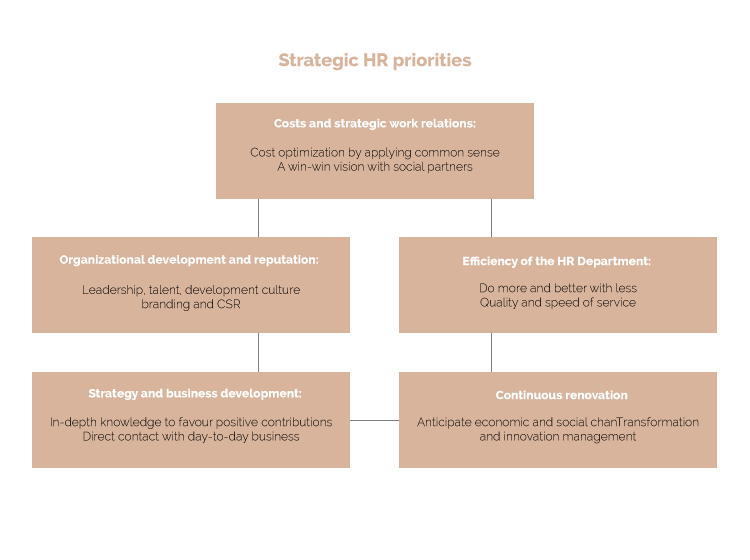David Reyero – Aedipe Centro – July 2013
In the present year, 2013, I turned 40 and, fortunately, I have not yet suffered the famous, or infamous, “crisis” associated with such an age. I did, however, make the most of the moment and stopped to think about the things I would keep the same and what I would do differently if I were to begin my professional life anew.
An interesting exercise is to “stop and think” about what is essential and what gives more value to people management and to analyze, in parallel, the current overall level of maturity of this key function.
To define such ideas, I have resorted to my 17 years of experience in Human Resources in very different companies and industries and to what I have learned from my frequent conversations with colleagues in a number of business and people management forums.
Here are a few thoughts I hope will help people management professionals in their daily work scenarios in such times of turbulence, numerous priorities and concerns.
1. Human Resource professionals have evolved a great deal in recent years, complementing the historical task of personnel or people management with a good technical level in the main key processes of people management (recruitment, development, compensation, labour relations…)
2. Although the function has increasingly gained strategic weight in companies, this positive evolution has had its ups and downs due to economic cycles, organizational culture, the profile and influence of HR professionals and the vision of companies’ senior management regarding people management.3. To consolidate this strategic role, I believe we should refocus our priorities and efforts to devote more time to strategic activities, in order to generate greater added value to companies on the basis of people management with greater long-term impact. According to the latest international studies, the time invested in the strategic aspects of human resources continues to be low (15% on average). In my opinion, these are the areas to which we should devote some “quality time”:
Knowledge and direct contact with company employees: Human Resource professionals must devote more time to “leaving their offices” and talking to people with different profiles. In particular, we have an obligation to understand the business in depth and establish direct contact with the teams who are closest to our customers in order to improve the solutions we provide and to gain credibility and internal influence. It is, therefore, essential that we boost our strategic focus and be permanently up to date with the latest developments in global business management, which will also be excellent synergy with our technical experience in people management.
Organizational culture: the big competitive advantage in the 21st century: We must devote greater time and effort to understanding “real” culture and to influencing people in the right direction with innovation, professional development and high staff performance and commitment as engines of change. We have a key role in this issue since an effective cultural change is not a simple top-down process defined by the General Management team. It should come from an interior transformation of each person on the basis of his or her understanding of the environment and new corporate needs, and must be well managed and accompanied by managers at different hierarchical levels.
Suitable diversity management: throughout my career I have realised that profile diversity is an essential factor in successful teams if it is properly dealt with in a whole-team context. The “daily creative tension” of interacting and having to influence different profiles accelerates innovation and, consequently, also generates better solutions than our competitors in that it integrates a range of different visions.
Simplicity: transactional and bureaucratic tasks and the volume of projects managed each year by the Human Resource department do not always bear out the philosophy that “Less is more”, which has proven its effectiveness in many successful companies. This steals time from us, time for thinking and working on what is essential: thinking about the future, developing our team, keeping ourselves up-to-date in external forums (and not just with Human Resource issues) or being in contact with our internal customers at different organizational levels. To this end, technology should help us to optimize the time spent on non-strategic tasks.
Integration and internal communication: due to the intangible nature of many of the issues we manage, the different processes and projects are not always well communicated or in line with a global company and people management strategy. This means that we should pay particular attention to the management of internal and external interest groups and involve them more in the initial phase of designing people management programmes so as to ensure their clear support and effectively manage possible resistance.
Run reasonable risks and challenge the status quo: as specialists in people management, we must urge employees at all levels to venture out and leave their comfort zones. We must continue to give the necessary impetus to bold initiatives such as advanced people-management policies and the development of leadership in times of crisis, but always on the basis of common sense and a well combined culture/strategy approach.
Identify the opportunities and not just the risks arising from each economic cycle in people management: if in prosperous times one of the most typical approaches is to opt for external selection, in times of crisis such as the present moment, we may make the most of the circumstances to strengthen internal development and reinforce a development culture that will be well perceived by our staff. There are successful initiatives such as the “non-obvious” horizontal promotions of employees to departments in which they have no prior technical know-how, a factor that has proved to be profitable for companies and is very well considered by staff members. This may improve commitment by overcoming the traumatic impact of frequent reshuffles and the resulting uncertainty.
Prioritization to increase our impact: “To be a strategic partner of the business, with high credibility, influence and contribution to the achievement of corporate objectives and transforming our organizations in excellent places to work”. This is the dream of most Human Resource professionals. I believe that, if we focus more on the essential areas of strategic people management, we will get progressively closer to it. In the model below there are some ideas relating to key issues which, in my experience, and on the basis of conversations with other colleagues, have been instrumental in generating this differential impact.
I am a “realistic optimist” as far as the future of human resources as a strategic department is concerned. Without minimizing the difficulties, and despite the crisis and everyday uncertainties, I believe that this is an area that will be increasingly consolidated in the coming years if we consistently manage to get closer to business and to people, to focus on our essential role and to take courageous decisions.


Leave a Reply